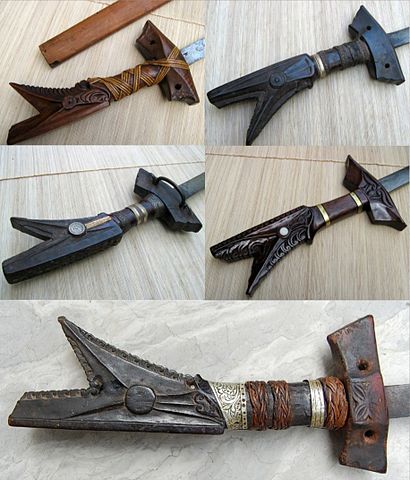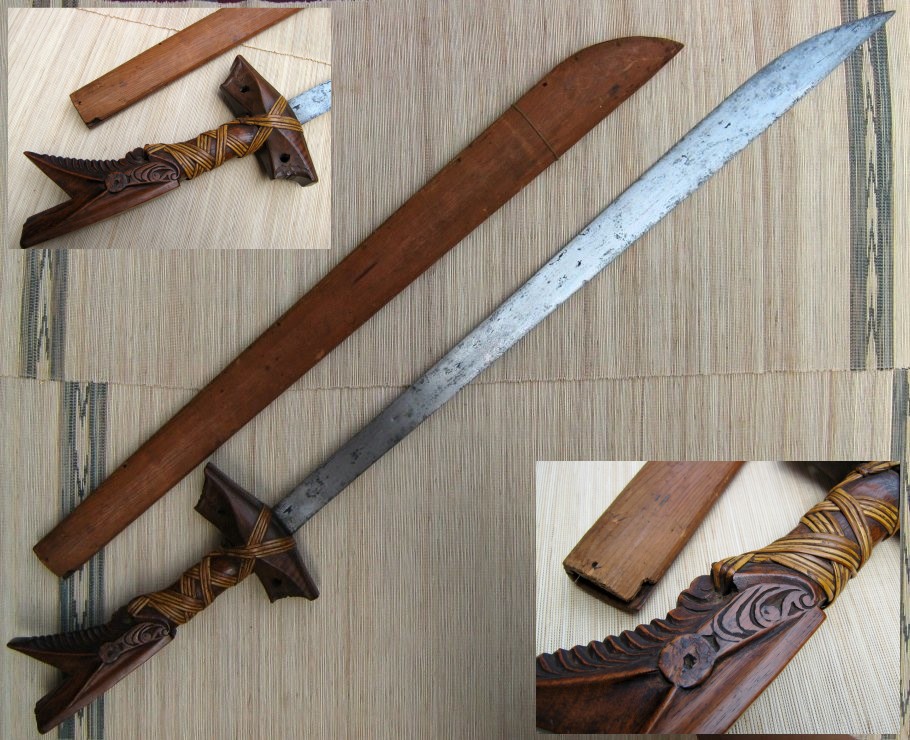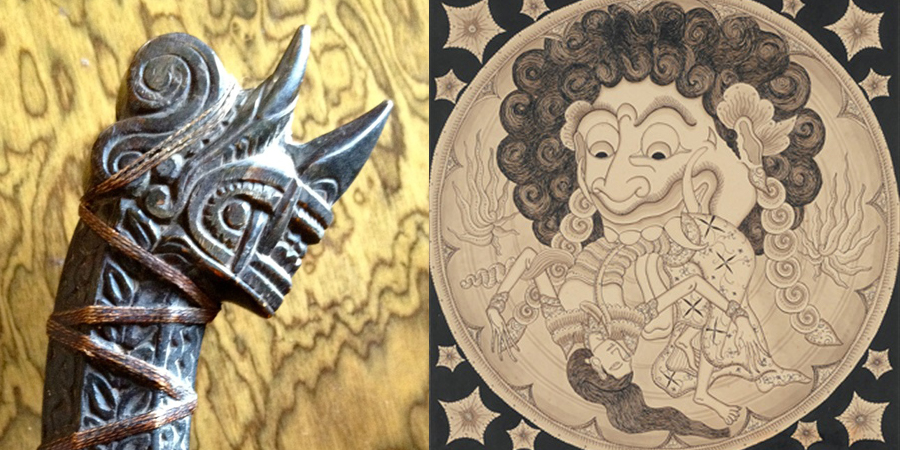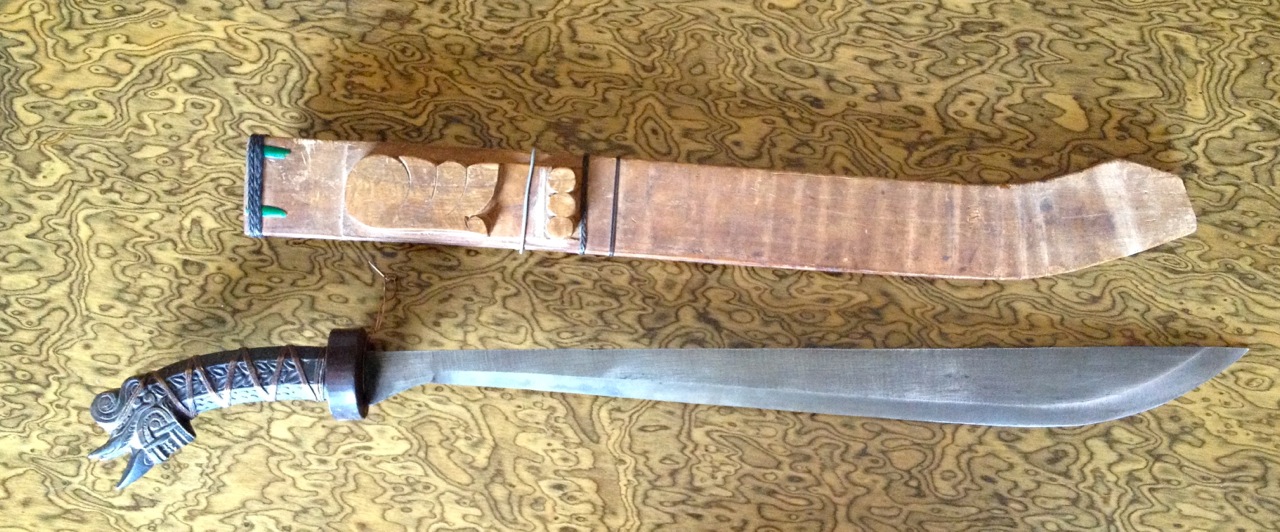Among Filipino swords, the most distinguishing characteristic of the Kampilan is its huge size. At about 36 to 40 inches (90 to 100 cm) long, it is much larger than other Filipino swords , and is thought to be the longest, although smaller versions (sometimes referred to as Kampilan bolos) may have also been common. It is believed that the longer kampilan was wielded only by the most skilled warriors or those with higher status. These swords were particularly deadly due to the deceptive and fluid fighting style enlisted by the user. The single edged blade was perfectly counterbalanced by the hardwood hilt, making it a formidable combat weapon. The most distinctive design element of the hilt is the Pommel, which is shaped to represent a creature’s wide open mouth. (Wikipedia)

The Mystery of the Bakunawa Sword Hilt:
Before moving on to the Tiyanak episode of our Creatures of Philippine Mythology series, I had to put one last point about the Bakunawa to rest. One reason Bakunawa is seen as such an important figure in Visayan Mythology is because of its apparent depiction on the hilts of the ancient Philippine Kampilan. The truth is, nobody is ever quite sure whether the serpent on these weapons represents a crocodile, snake, Bakunawa, or other mythical Nāga (Sanskrit word for a deity or class of entity, taking the form of a very great snake or serpent). To make matters more confusing, the best weapons experts in the Philippines (and other countries) continually categorized the dragon-like hilt seen below as a crocodile. If this is a crocodile, what did the Bakunawa hilt look like?

Answered by Balinese Mythology:
Since launching The Aswang Project just over a year ago, I have been able to share ideas with like-minded people from all over the world. Last month, Adam Fuqua contacted me through our YouTube Channel and we were able to solve this nagging puzzle. First, I can admit when I’ve made a mistake. While visiting weapon forums, I found hundreds of kapilan images and picked out the ones with hilts that ‘looked’ like a dragon. Many of these were claiming to be “Bakunawa” but, upon further research, were actually crocodiles or nāga. In addition, most of the older surviving specimens are of Moro making, as the Visayans moved away from the kampilan for the more practical tenegre and sundang. Without finding any definitive information, I begrudgingly abandoned the idea of including it in the Bakunawa episode of the web series. I should have followed my own research on the evolving stories of the colossal serpent – which is what Adam did.
“I read your article. Those heads are different than the ones I’ve seen associated with Bakunawa. (Referencing an article on hariragat.blogspot.com) He has the buwaya hilt pictured (the crocodile/alligator that you reference) and the Bakunawa. Visually, it probably does back up your ties to the Rahu god, since its face reminds me of things you’d see in other places in SE Asia with similar influences. (Referencing an article with a sundang hilt on vikingsword.com) Here are some Panay (Visayan) examples from a sword forum. I thought this link might interest you in specific since they seem to have some examples from Capiz and I know you spent some time there researching your original video.”
The common assumption is that Bakunawa is an indigenous legend, and developed independently as part of ancient astronomy and rituals in the Philippines. This thought is complicated by the incorrect notion that Bakunawa became a “demon” after the Spanish arrived with Catholicism. In reality, stories of Bakunawa are directly linked to the Hindu demi-god “Rahu”, from India’s Vedic period ( c. 1500 – c. 500 BCE) and were brought to SE Asia through the expansion of the Indianized Kingdoms around 200BCE. The stories travelled to areas of the Philippines through trade and subsequent migrations from the Malay Peninsula between 200-900CE as an offshoot of Balinese Mythology, where Kala Rau is a demon and the cause of the lunar eclipse.
< Kala Rau, the moon eating demon in Balinese Mythology. Image courtesy of http://www.aboutnatia.com/[/caption]
Thanks to Adam, I am now able to juxtapose an image of a Visayan Bakunawa sword hilt with an image of the Indonesian demon “Kala Rau” (seen eating the moon deity). In my research, I put too much emphasis on the notion of Bakunawa as a serpent, and hadn’t considered that the image represented on the sword hilts had not evolved further from the Indianized image of Kala Rau. We can now say with certainty that the Visayans had Bakunawa on their sword hilts and we know which designs to look for.

I was beyond thrilled to finally connect the Visayan kapilan hilt to the story and myth of Bakunawa and it’s Hindu/ Balinese origins. I am sure contrary arguments could be made amongst the amorphous kampilan designs throughout the archipelago, but when myth and reality share such a definitive historical connection, we can take one step closer to certainty.

If you are interested in learning more about the evolution of Bakunawa, please check out our 14 minute documentary.
Jordan Clark is a Canadian born descendant of Scottish immigrants living on the homelands of the Lekwungen speaking peoples. His interest in Philippine myth and folklore began in 2004. Finding it difficult to track down resources on the topic, he founded The Aswang Project in 2006. Shortly after, he embarked on a 5 year journey, along with producing partner Cheryl Anne del Rosario, to make the 2011 feature length documentary THE ASWANG PHENOMENON – an exploration of the aswang myth and its effects on Philippine society. In 2015 he directed “The Creatures of Philippine Mythology” web-series, which features 3 folkloric beings from the Philippines – the TIKBALANG, KAPRE and BAKUNAWA. Episodes are available to watch on YouTube. Jordan recently oversaw the editing for the English language release of Ferdinand Blumentritt’s DICCIONARIO MITOLÓGICO DE FILIPINAS (Dictionary of Philippine Mythology) and is working on two more releases with fellow creators scheduled for release later this year. When his nose isn’t in a book, he spends time with his amazing Filipina wife of 20 years and their smart and wonderful teenaged daughter.


